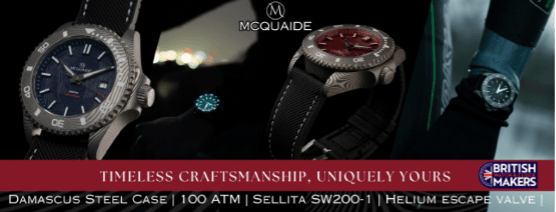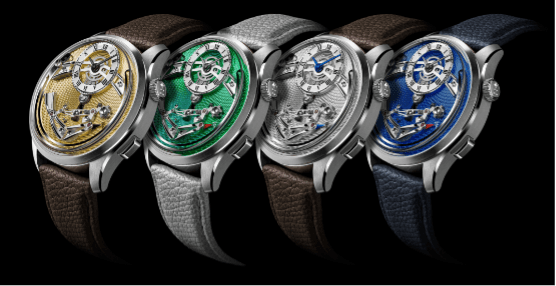America's tariff rate is hitting independent watchmakers harder and faster than the industrialists
The biggest Swiss watch brands are believed to have anything between one and six months’ worth of stock in the United States.
Swiss manufacturers export to their in-country offices at around 50% of their retail value before selling watches to retail partners or to internal stores including their US ecommerce sites.
Importing a watch at half its retail value goes a long way to mitigate last week’s additional 29% tariff slapped on top of the 10% hike in April for all timepieces and parts (new or used) that originated from Switzerland.

This explains why most commentators are expecting retail price increases of around 10% for the biggest wholesale brands such as Rolex, Omega, Cartier and Patek Philippe.
Taken together, this wholesale model and a build-up of stock in the US channel, has given breathing room for Swiss watchmakers contemplating their response to the 39% tariff while working quietly in the background to influence discussions between Bern and Washington DC on a new trade deal.
Direct to consumer watch brands face a much more immediate challenge.
Many take online orders from the United States and send watches directly from Switzerland to customers, every one of these orders that landed in the US after August 7 would incur the full 39% tariff.
Brands can either eat that cost, pass it onto consumers or a bit of both.
Breitling’s CEO Georges Kern has also suggested this week that prices could rise around the world to offset the cost of the American tariff for Swiss-based manufacturers.
British-based direct to consumer watch businesses are taking different approaches to this challenge that, for many, is coming from their biggest and fastest-growing market.
Bristol-based Fears has a hybrid model of both DTC and wholesale in markets including the United States. Wholesale is becoming the majority of its business, according to its managing director Nicholas Bowman-Scargill.
When the first tariff of 10% hit in April, Fears was able to cover the tariff for DTC and wholesale sales to the United States.
The tariff rate was also under 10% because Fears watches are not “Swiss Made”. It sources from suppliers around the world — predominately from Switzerland — and assembles in the UK.
Piling an additional 29% tariff rate to make it the current 39% changed the arithmetic for Mr Bowman-Scargill, who took the decision to appoint a distributor in the USA that imports all Fears watches and then ships them on to the final consumer.
“This adds a couple of days to the process but reduces the costs to us and ensures the final owner of a Fears in the US doesn’t have to pay anything more than the price they see on the website,” he describes.
Fears is also looking at establishing a US subsidiary that could take control of importing and forwarding more efficiently.
Fears prices have been nudging upwards, but not enough to impact demand.
“I’m pleased to say this has resulted in us seeing no drop off in sales from the US, which is a significant market for Fears,” Mr Bowman-Scargill tells WatchPro.
Farer, another British-based indie that describes America as its most important market, has already established a subsidiary to act as its own importer to the country.
This helped it to keep prices steady when the April tariff of 10% was introduced, which contributed to sales over the past five months rising markedly in the US, according to Farer managing director Paul Sweetenham.
However, he says the 39% tariff on his Swiss-made watches is “new territory”, particularly as it will hit goods entering the country, regardless of price.
There is a window this month when watches with a total import value of under $1,500 would not be hit with the new tariff, but that changes from September if a trade deal cannot be agreed.
“Without doubt if this tariff, certainly if this level stays in place, then US demand will be reduced, by how much I don’t know,” Mr Sweetenham tells WatchPro.
“Farer operates one off the lowest margin multiples in the business so we hope with the tariff added, it does not become too much of an impediment to purchase,” he adds.
If Americans stop buying, Farer hopes it can compensate with growing sales in Europe and the Middle East.
“We are still of a size where we can pivot and have a modest headcount of well-paid highly-skilled folks who can multitask and largely absorb the challenges we are exposed to,” Mr Sweetenham suggests.
While Fears and Farer are now selling at wholesale prices to American importers, the biggest of the British independent watch businesses, Christopher Ward, has taken a different approach by continuing to ship directly to its consumers.
Its ecommerce site also presents prices differently to most brands.
Logging in from the USA, dollar prices are presented before sales taxes (which vary state-by-state but average 7.5%) and other taxes and duties, including import tariffs, which are added during the checkout process.
Americans are familiar with state sales taxes being added at checkout, but adding import tariffs is unusual.
Browsing on christopherward.com last week, and logging-in as a client from Albany, NY, the award-winning C1 Bel Canto Classic was advertised for $4,225, the same as its price at launch.

However, after adding 9% sales tax of $374.97 for a New York State resident and customs duty of $674.03, the final price became $5,274.
That was when the 10% tariff applied.
Today, with the 39% tariff in force, the watch is still advertised for $4,225, but that imaginary customer in Albany is now being charged $6,462.28 thanks to the addition of $1,899 in duties.
Flip back to to the UK ecommerce site, and the same Bel Canto is offered for £3,495, all-in. At today’s exchange rate that converts to around $4,700, a saving of $1,762.
Americans in the market for a Bel Cano probably won’t jump on a plane to the UK, even if the saving is more than the cost of a flight, but that may not be the case for a six-figure timepiece from one of Switzerland’s feted independents.
Speaking to one such indie this week, who asked to remain anonymous, WatchPro was told: “DTC from Switzerland will disappear as no American is going to pay 39% over retail to buy a watch. A lot will start flying over [to Switzerland] or use their travel to any place in the world to collect. It will induce a smuggling economy exactly like India or China”.
Duty should be paid on a new watch flown back in a client’s hand luggage, but some sellers are already offering to courier boxes and papers separately so a watch can be worn on the wrist on the way through the green channel.
This not only risks a fine in addition to the duty payment, it could also cost American jetsetters their treasured Global Entry status where Transport Security Administration PreChecks allow trusted members to speed through customs.
One retailer told WatchPro that the convenience and time saving that this trusted status bestows is worth more than even five-figure savings from not declaring a new watch on entry to the country.
Different types of customers have different motivations, but are most sensitive to price in the hyper-competitive microbrand watch market.
Duckworth Prestex, another UK-based indie, admits even the 10% tariff hit US sales.
“We have noticed a significant drop in orders in June and July from the USA,” the company’s founder Neil Duckworth reveals. “For our customers I think [the tariffs] mean uncertainty and confusion. They don’t know what is happening exactly and how the tariffs will affect them.
Duckworth Prestex advertises its watches in the United States with tariff costs included. These vary depending on whether they are Swiss-Made models or those assembled in Hong Kong using Japanese movements.
Mr Duckworth says American customers usually still buy once the tariff situation is explained, but many do not ask. “Those that don’t ask presume the worst I suppose and don’t order,” he suggests.
Like the rest of the industry, he is hoping that a trade deal can be reached that reduces the headline tariff rate for Swiss watches closer to the EU’s 15%. Failing that, the hope is simply that customers get tired thinking about tariffs and just consider each watch and its price on their merit.
